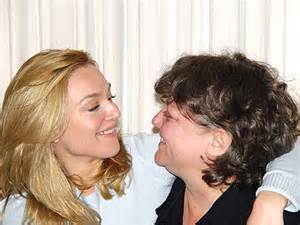You might recognize me from some of my acting gigs -- Law and Order, American Hustle or more recently, The Last Ship and Joy -- but the roles that define me the most are the personal ones: daughter, mother and today as a passionate advocate for the American Heart Association.
Today, with this column to commemorate American Heart Month, I want to tell you about my amazing mother, Lisa, who died too young from heart disease at the age of 60... and my exquisite aunt Laurie, who was passionate about life but lost her own to the same affliction at age 67... and as someone who feels blessed to share life and laughter with my father, who survived triple bypass surgery.
As a result of these life experiences, I am working with the American Heart Association to share my story and channel it into something positive. Especially now, as I live a new and exciting role as a mom, I want to pass on to my daughter a legacy of lessons I've learned from my experiences, struggles and triumphs.
Life lesson #1: Education and preparedness are important. They can save lives.
My mother and my aunt were both very spiritual, very strong women. My mother taught me that it's my responsibility to speak up and to care about others. Look at what we've done in disease areas like breast or prostate cancer where people have come together to create change. We can raise awareness, raise consciousness and change the lifecycle of the No. 1 killer of Americans -- heart disease.
Elisabeth, shown here with her mother, wants everyone to know the signs of heart disease and to learn CPR. It's a cause she began supporting after the unexpected death of her mom.
Life lesson #2: Take your health seriously. And help others do the same.
Heart disease is the leading cause of death in the world. It can be very, very hard to recognize the symptoms. It could be back pain. It could be nausea. It's just an elusive disease, and unless it's targeted your family, you may not know that you're suffering from something that can be devastating.
Neither my mother nor my aunt knew their signs until it was too late. Both of them didn't know what to look for, and they weren't able to understand what their bodies were telling them.
At an even earlier age, when I was 10 years old and my father was 40, he stepped out on to Central Park South and suffered a massive heart attack, which led to a triple bypass surgery. That he survived was a success story. That isn't often the case. Reflecting on my mother's and my aunt's passing, I am filled with such gratitude that my father is still with us today. Living is a privilege and each moment we have to share with our loved ones is a gift. There are no guarantees that the people you love the most will sustain their health and live a long life with you. But it is my purpose to take this sadness, and turn it into empowerment and knowledge for others.
Life lesson #3: Get trained to save a life. Take a CPR course.
My step-dad didn't know CPR. Had he known how to perform it, he might have felt more prepared to help my mom. CPR is a lifesaving skill that everyone should learn each year. Think about this: more than 359,000 people suffer cardiac arrest outside a hospital setting every year. Almost 70 percent of those happen in the home. That means that you may very well be called upon to save the life of someone you love. If a family member or a friend dropped to the ground in front of you, would you know what to do? In a cardiac arrest, seconds count -- immediate CPR, whether it's performed with rescue breaths or Hands-Only CPR, can double or triple that victim's chance of survival.
I'm just one person, but many people throughout the United States and the world share my experience. My story is their story, because they have lost loved ones to heart disease just like I have.
Each of us is shaped by our own experiences, but we're more alike than different. We all have mothers, fathers and grandparents, and many of us have children. We have friends, coworkers and others we care about. We want the best for all of them and future generations.
Together we can create change and save lives. We can start by learning Hands-Only CPR. All it takes are two simple steps: call 9-1-1 and push hard and fast in the center of the chest until help arrives. And I really want more people -- millions more! -- to take a CPR class.
By collaborating we can help end needless suffering and save lives. Join me this month in committing to become a lifesaver -- and to living a healthier, longer life.
This post is part of a series produced by The Huffington Post and the American Heart Association's Go Red For Women in recognition of National Wear Red Day (Feb. 5, 2016), the aim of which is to raise awareness that heart disease isn't just a man's disease, and 1 in 3 will die. But 80 percent of cardiac and stroke events may be prevented with education, lifestyle changes, and action. To read all the stories in the series, visit http://www.huffingtonpost.com/news/heart-disease/. And to follow the conversation on Twitter -- and share a picture of yourself wearing red -- find the hashtag #GoRed.
